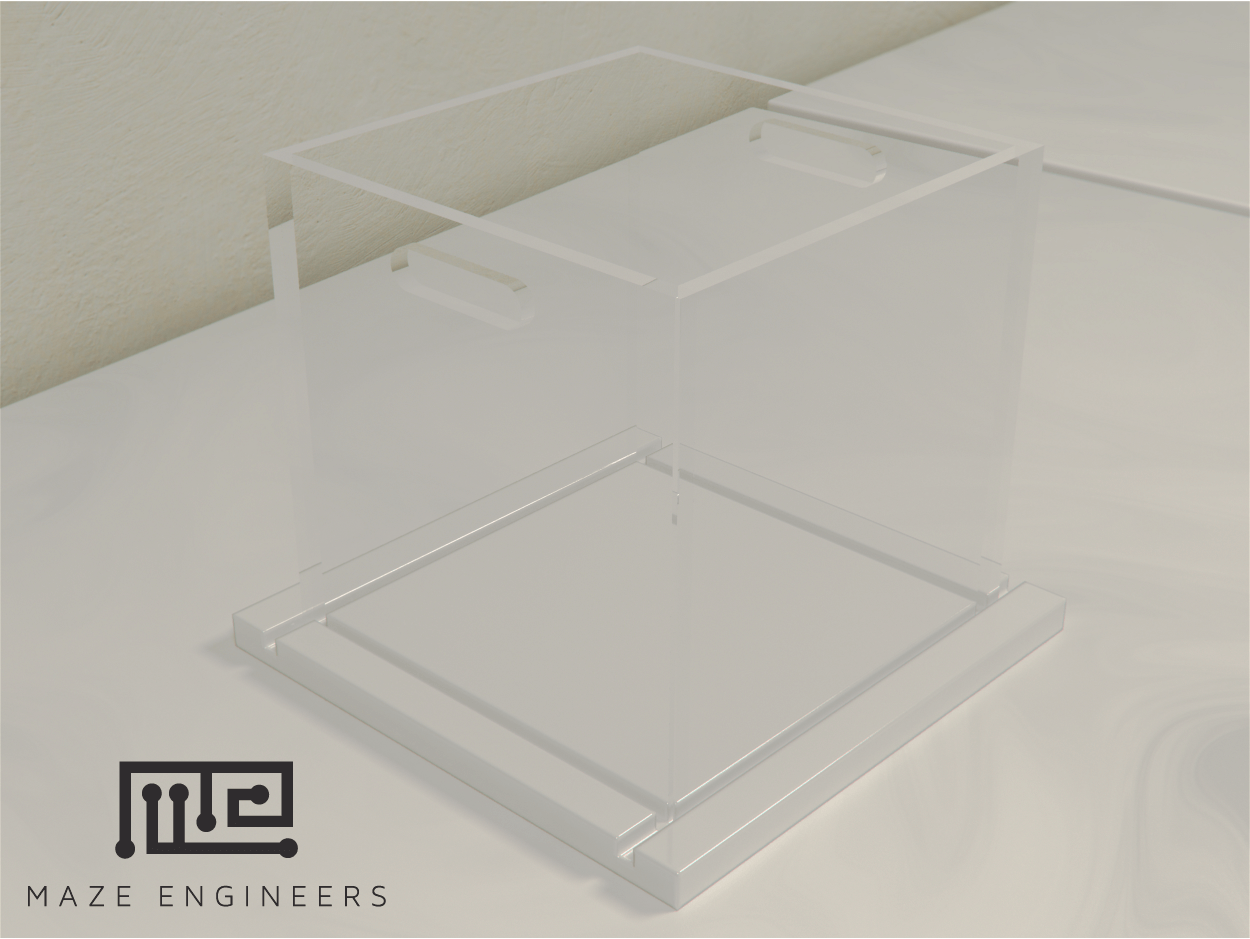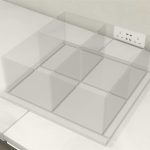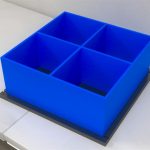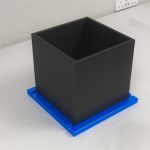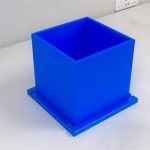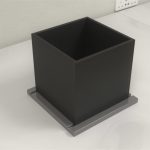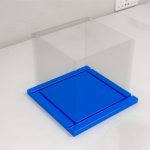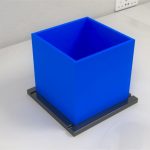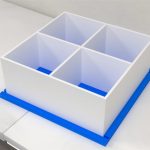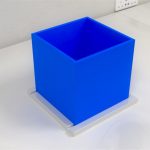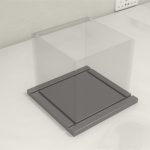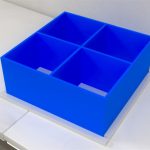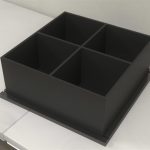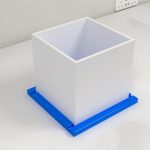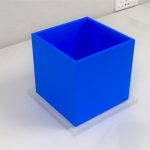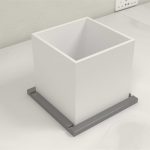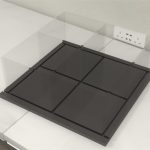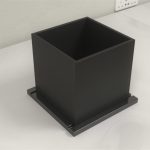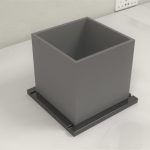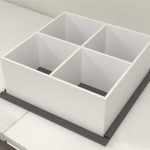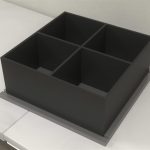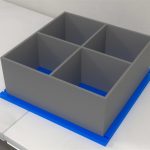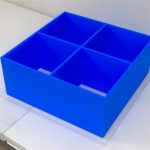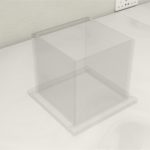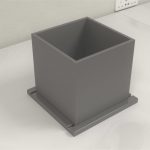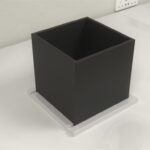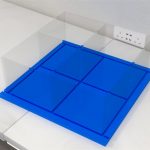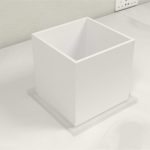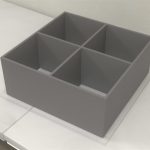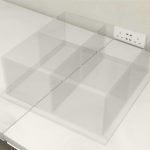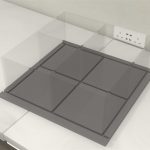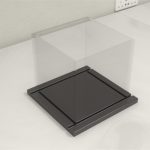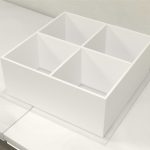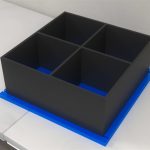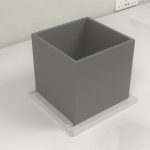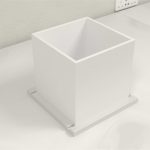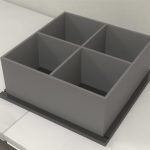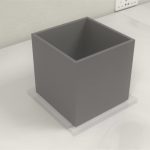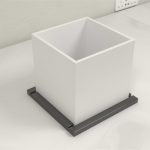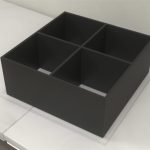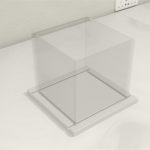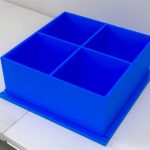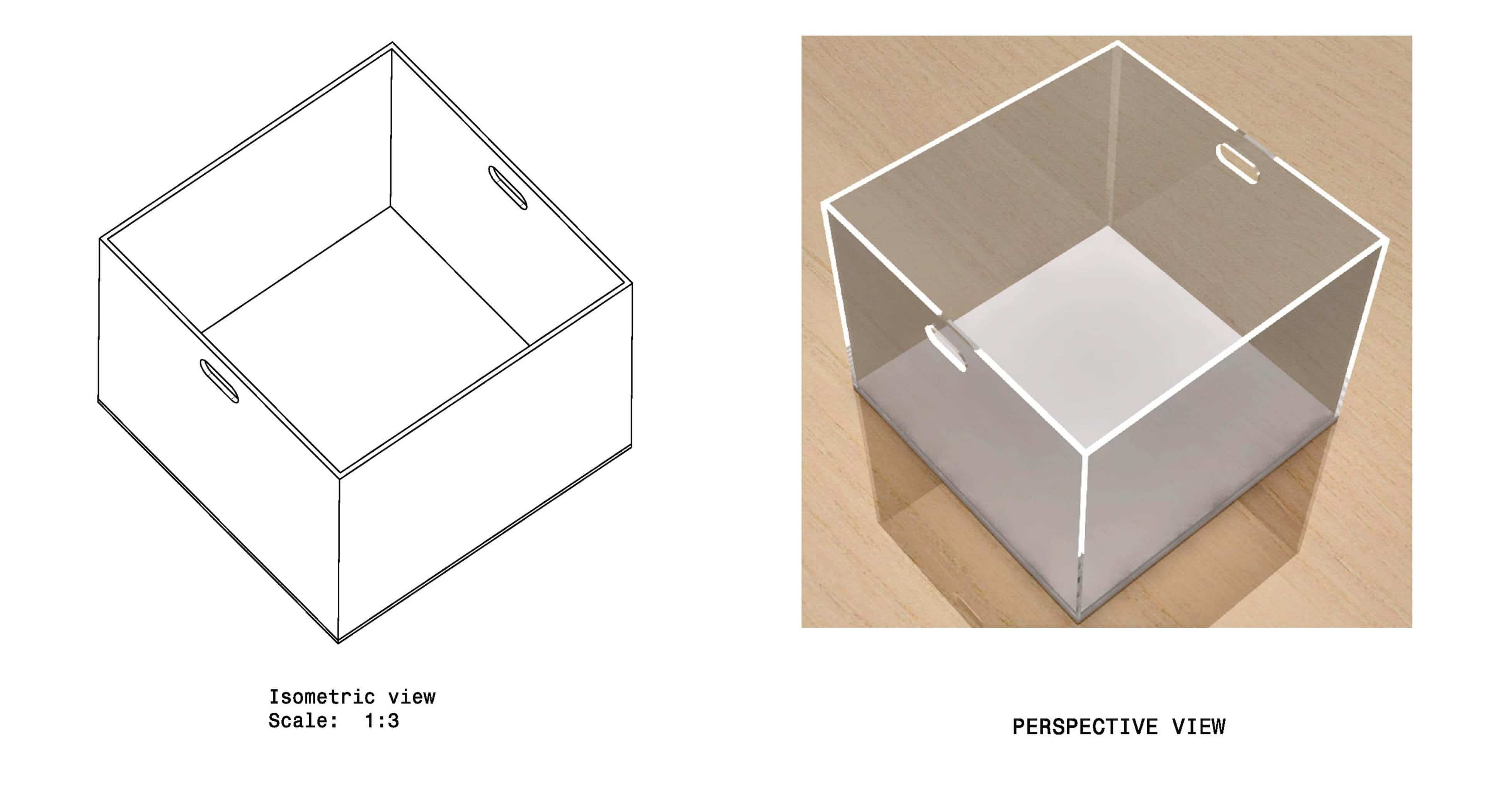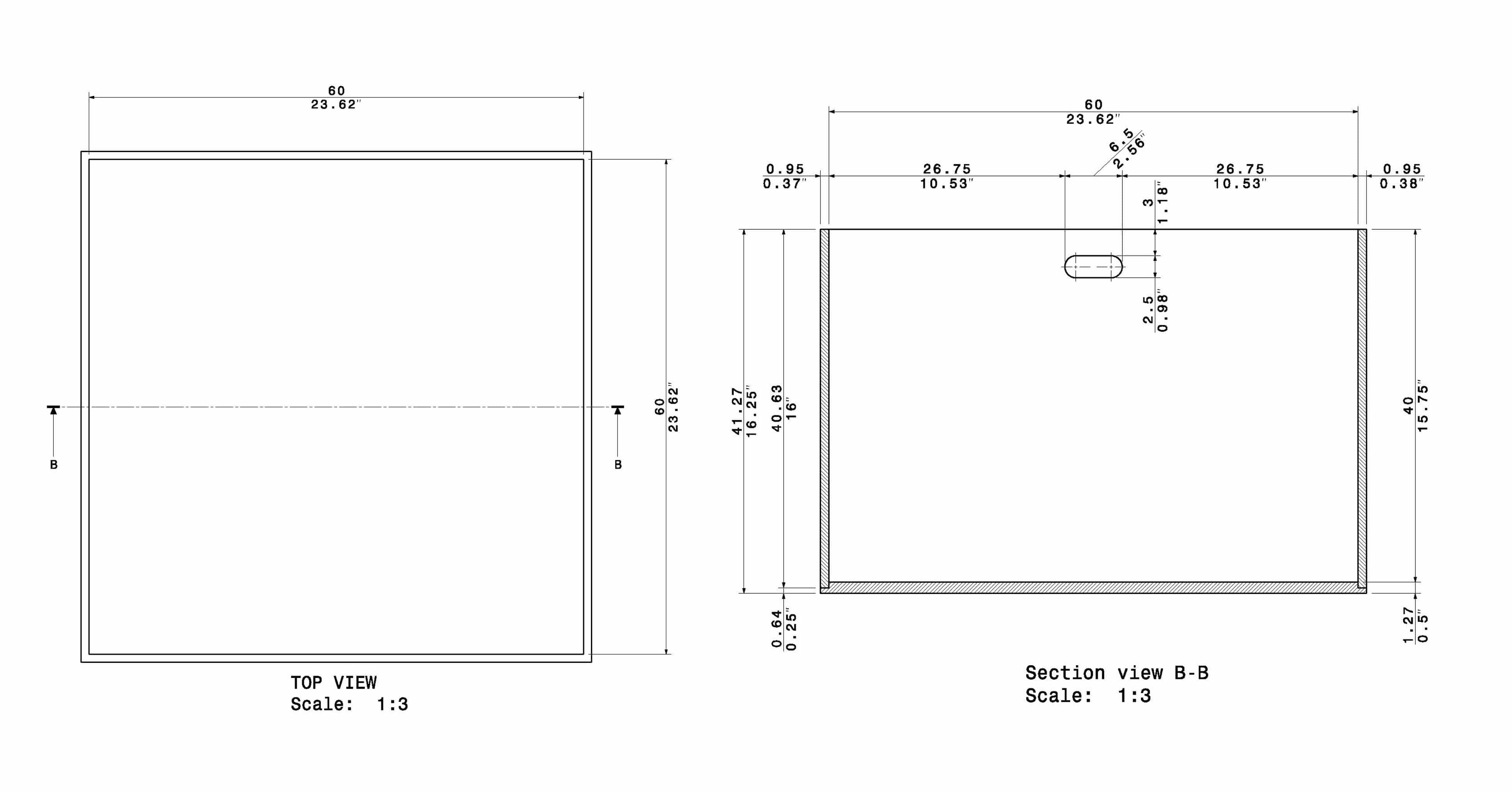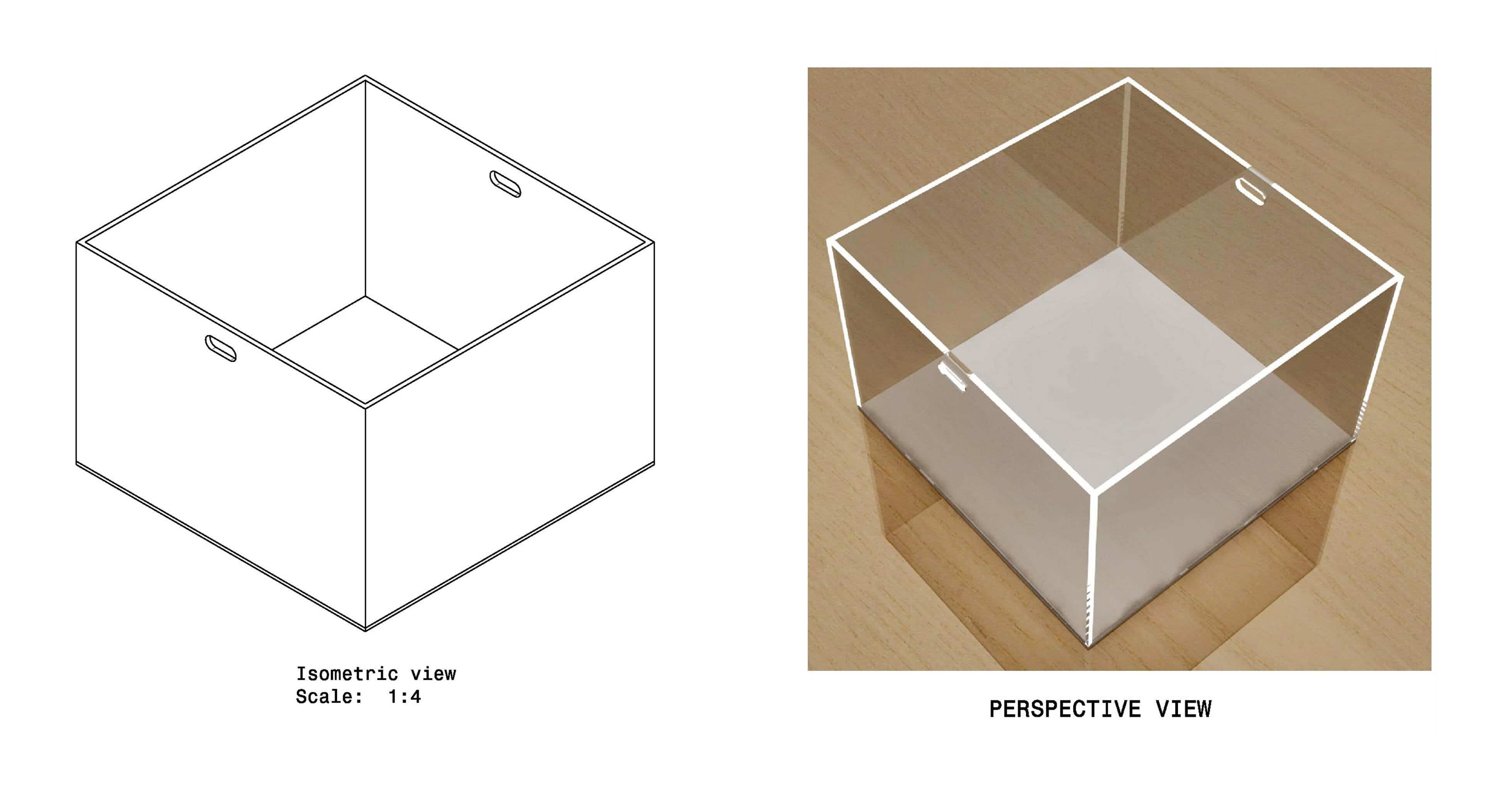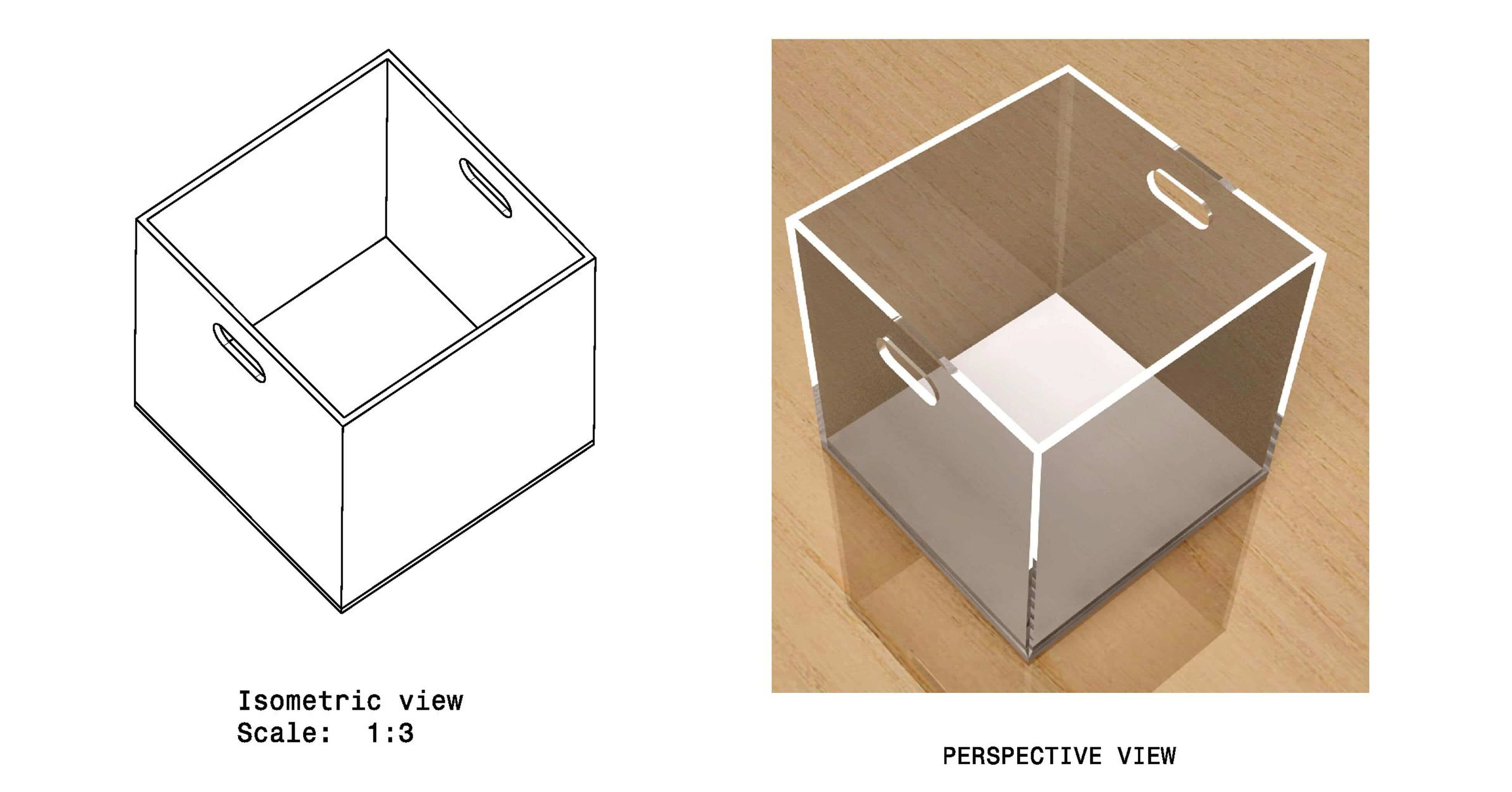The open field test is a popular protocol used to assess exploratory behavior and anxiety in rodents. Thigmotaxis in the open field is used to evaluate anxiolytic, anxiogenic and non-pharmacological treatments as well as genetic manipulations. Ambulation is the most common behavior studied with the open field, but others such as latency or rearing can also be measured. In addition, objects can be added for a modification similar to the novel object recognition field.
Walls can be both opaque (grey, blue, white, black) or clear. We recommend that clear walls are used for measurements of anxiety behaviors, while opaque walls are used if assessments include novel object recognition. A grid floor insert is available for tracking purposes.
Our Open Field is compatible with all major video tracking and analysis packages including our complete tracking and analysis package ConductVision, Noldus Ethovision XT,and ANY-Maze.
Prices and Sizes
Mouse
$ 650
+ Shipping and Handling (approx $100)- 40×40 cm; 30cm height
- Removable base for easy clean
- Acrylic
- Easy clean with 70% Ethanol
- Matte Finish for non-shine
- No odors
Rat
$ 790
+ Shipping and Handling (approx $150)- 60×60 cm; 40cm height
- Removable base for easy clean
- Acrylic
- Easy clean with 70% Ethanol
- Matte Finish for non-shine
- No odors
XS (Stroke)
$ 540
+ Shipping and Handling (approx $80)- 25cm x 25cm; 25cm height
- Removable base for easy clean
- Large singular box can serve as large Open Field
- Separator included dividing into 4 individual mouse/rat boxes
- Acrylic
- Easy clean with 70% Ethanol
- Matte Finish for non-shine
- No odors
Mouse (Set of 4)
$ 2190
+ Shipping and Handling (approx $300)- Total size: 80cm x 80cm, 30cm height
- With wall insert
Rat (Set of 4)
$ 2890
+ Shipping and Handling (approx $700)- Total size: 120cm x 120cm, 40cm height
- With wall insert
XS (Stroke - Set of 4)
$ 1790
+ Shipping and Handling (approx $150)- Total size: 50 x 50cm; 25 cm height
- With wall insert
Modifications
Floor Insert

Mouse - 40x40cm to fit
Rat - 60x60cm to fit
Inquire for Cost
Contextual Modification
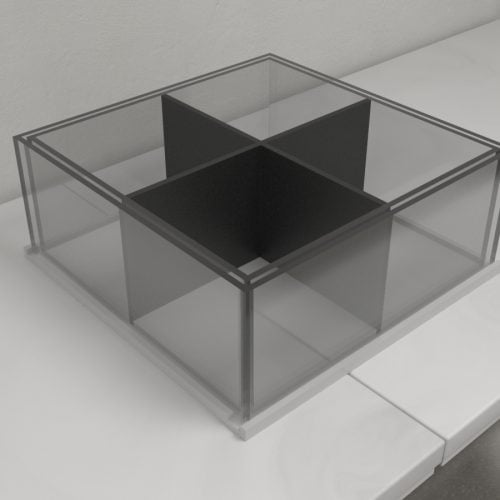
To fit
-Striped
-Polka dots
-Square Tiles
-White plates
-Black plates
Camera Gantry
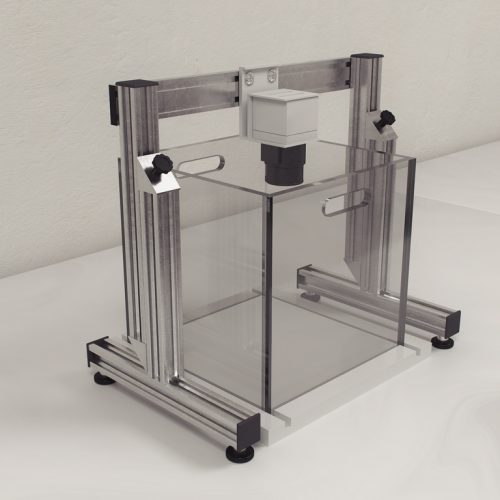
Shock Insert
Ziggurat Task
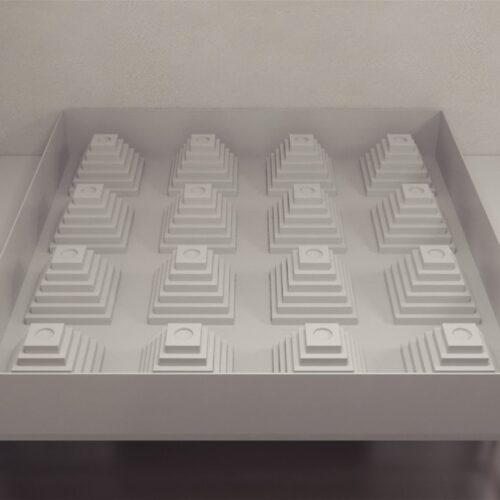
Autoclave Model
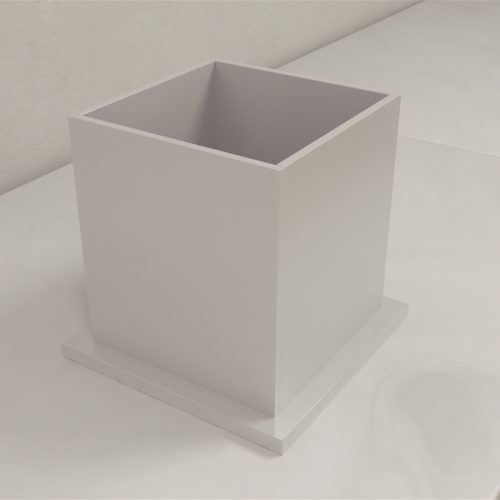
Need tracking software?

CONDUCTVISION:
Behavorial Analysis of the Future
Highly advanced AI Technology designed to analyze only the most rodent behavorial movements.
Dimensions
Documentation
Introduction
the open field test is a simple apparatus used in the assessment of locomotion, exploration, and anxiety. The open field task explores the innate responses of the subject to open spaces apart from their explorative drive. Thigmotaxis is often seen in rodents such as rats and mice. This behavior is characterized by avoiding brightly lit open spaces and is believed to be an evolutionary adaptive behavior that can be observed in many species. The open field test exploits this fear in species to evaluate the different aspects of anxiety-related behaviors. Animals with a decreased level of anxiety are more likely to explore the central area of the open arena than animals with high levels of anxiety. Animals with high levels of anxiety will display reduced locomotion and exploration, with a preference to stay close to the walls of the open field arena. However, despite the fear, animals have also been known to explore threatening stimuli as part of their exploratory drive.
The apparatus was developed in the early 1930’s by Calvin S. Hall to observe rat behavior in an open arena (Hall & Ballechey 1932). Hall and Ballachey’s experiment used a square arena that was marked into a grid. The experiment involved the observation of the rats to food stimulus placed within a barrier in the center of the arena. This experiment allowed observation of the influence of a positive stimulus on the thigmotaxic behaviors of the rats and their emotionality. Though the apparatus is useful in the assessment of anxiety and explorative behaviors, it is debated that the task does not provide a specific measure of anxiety. To overcome these shortcomings, the 3-D Open Field apparatus can be used to allow a more precise measure of anxiety and fear-related behaviors.
The open field test is usually used alongside other mazes that measure anxiety, such as the Elevated Plus Maze, Elevated Zero Maze, and Elevated Y-Maze (see also T-Maze), following anxiolytic and anxiogenic treatments. The Ziggurat task is a variation of the open field apparatus that uses ziggurats in the open space to create a complex environment. Another task that uses a similar apparatus to the open field task is the Novel Object Recognition task used to evaluate the subject’s responses to novel objects.
The open field apparatus has a simple construct. Usually, a square arena that is surrounded by high walls to prevent escaping is used, though circular arenas are also used. These walls can be transparent to allow the subject to view any visual stimuli placed around them or can be opaque to limit observation of behaviors in response to brightly lit open spaces. The floors are often marked with square grid crossings, and the center of the arena is marked with a square. In addition, the apparatus can have additions and modifications to test different behaviors and responses.
History
Origin
The first use of an open field was described in Hall and Ballechey’s 1932 paper, “A study of the rat’s behavior in a field: a contribution to method in comparative psychology.” In their experiment, they utilized a 7 x 7-foot walled arena that had been marked into 49 square grids. In the center, a cylinder wire mesh covering 25 squares was placed to contain a food reward. When the animals were introduced into the arena from a start point, it was observed that the presence of a food reward resulted in animals circling the wire-mesh barrier more than when no food reward was present. A similar set-up was once again used by Hall in his 1934 experiment to highlight “the importance of needs or drives and emotionality as factors determining adjustment or maladjustment” (Hall, 1934a). In the same year, Hall published a paper aimed at validating the correlation between defecation and urination and the individual emotionality of the rats in an open-field task (Hall, 1934b). Although, it has been argued that a measure of defecation or urination simply measures timidity in a controlled environment.
Hall’s experiment for determining the relationship between emotional behavior and the speed of ambulatory activity in an open field task suggested that emotional rats tended to be less active than their non-emotional counterparts (Hall, 1936). This behavior was further observed by Hall in the “The inheritance of emotionality” paper published in 1938. In the experiment, it was observed that males were more likely to be emotional than females and the quality of emotionality was inheritable as evident from the higher defecation and urination rates of the progeny of most emotional males and females compared with the progeny of least emotional males and females (Hall, 1938).
Development
Since its initial use as a test for emotionality by Hall (1938), the open field task has seen different modifications and adaptations and a wider range of applications. In 1945, Anderson utilized the open-field task to assess timidity and the role of gender in timidity in normal and gonadectomized rats. The results of the investigation showed that the females were less timid than their male counterparts and that gonadectomy before puberty did not affect the sex difference in timidity,
Stern (1957) evaluated the effect of frontal area lesions on the behavioral performances of male albino rats in an open-field task. The author found that the subjects with frontal lesions showed similar and long-lasting behavioral changes in the open field as animals subjected to a series of electroconvulsive seizures (ECS). Subjects showed an increase in emotionality and changes in behavior were more gradual than in the ECS animals.
The effect of aging on the open field behavior was evaluated by Werboff and Havelena in their 1962 paper. Their test assessed the performances of both sexes of Sprague-Dawley at ages 90, 180, 360, and 540 days. The evaluation of age and gender-based performance in the open field concluded that activity and emotionality declined with increasing age and that the females exhibited higher activity and emotionality scores than the males.
Levine et al. (1967) evaluated the relationship between open-field behavior and changes in adrenal corticoid in male Purdue-Wistar rats. The animals were grouped into two groups based on if they had been handled in infancy or not. The animals were tested on the open field for 4 days in their adulthood and were immediately killed at the termination of the test. As expected animals that were handled in their infancy were more active in the open field task, defecated less on all days of testing and had lesser corticosterone response throughout the testing period.
Recent Developments
Itoh et al. (1994) investigated the behavioral effects of neuromedin B (NMB) and neuromedin C (NMC) in an open field task using male Wistar rats. Subjects were intracerebroventricularly (ICV) administered either 5 μl peptide or saline and tested at 1 and 30 minutes after administration in the open field. At both evaluation points a decrease in the duration of locomotion, the distance moved, and rearing behavior was observed with an increase in excessive grooming and violent scratching. However, the pronounced behavioral changes after 30 minutes was only observed in NMC-administered rats.
Brotto’s et al. (2000) experiment assessed the effect of chronic melatonin administration and sex differences in forced-swim test and open field task. Results from both tests showed that females displayed higher activity than males. Melatonin administration led to decreased activity in the forced-swim test while increasing ambulatory behavior in the open field task for both genders. The study concluded based on both the tests results that melatonin, in general, did not have an inhibitory effect on the motor activities of the subjects.
Popović et al. (2014) tested the effects of low and high doses of anti-nausea medication on the open field habituation task using male Wistar rats. Subjects were administered either 1 mg/kg (low dose) or 30 mg/kg (high dose) of anti-nausea medication soon after their acquisition task in the open field. Behavioral observation of the subjects after reintroduction to the open field after 48 hours showed that subjects treated with a low dose significantly decreased grooming while the opposite was true for subjects treated with a high dose of anti-nausea medication. Further, the defecation rate was maintained in the low-dose group while it increased significantly in the high-dose group. Based on the data it was concluded that post-training anti-nausea medication administration increased defecation and grooming, behaviors that are associated with fear and stress.
Apparatus and Equipment
The open field apparatus is a square arena that is available in default small mouse, mouse, and rat sizes but can be customized in dimensions. The arena is surrounded by high walls to prevent the subjects from escaping the apparatus. In general, the walls are clear. However, opaque colors and matte finishes are also available. Floor inserts for the apparatus are available with or without gridlines. These gridlines divide the area into equal smaller squares and can be helpful for both manual scoring, as well as video recording and scoring with tracking software. A square area in the very center of the area may also be outlined.
Training Protocol
The open field test is used in the assessment of exploration, locomotion, and anxiety. The test can be used to compare animals in a control group to animals in a treatment or disease model group by observing their behaviors and tracking their movements in the open field. Animals with minimal anxiety are likely to move about the area and perform other behaviors such as grooming and rearing, while animals with increased anxiety may freeze or exhibit stretch-attend postures.
Prior to beginning the experiment, the apparatus should be thoroughly cleaned to prevent the influence of any lingering stimuli. Overhead lighting set-up is recommended to prevent shadows. The arena should be sufficiently, but dimly, lit to allow subjects to see and explore their surroundings while avoiding stress from bright lights. Observation of the Open-Field task can be done using tracking software and video camera, such as Noldus EthoVision® XT or ANY-Maze video tracking system mounted above the apparatus. Live scoring is also possible.
Since the open field task is based on the novelty of the environment, the test does not require any pre-training. The subject is placed in the center of the arena, and its behaviors are observed for a period of at least 5 minutes without any interference.
Modifications
The simplicity of the open field apparatus makes it a highly modifiable apparatus. Simple modifications include using opaque walls, different lights, different floor inserts (shock floor inserts) and varying the size of the arena. Each modification can be tailored to the needs of the research with the open field apparatus.
The Ziggurat task apparatus is a modification of the open field that uses ziggurats to create a complex environment for the subject to explore. The task involves assessment of the subject’s spatial memory and navigation (Faraji et al., 2008). The novel object recognition task is another battery that uses apparatus similar to the open field task. This task is commonly used in the assessment of memory and response to novel objects (Bevins & Besheer 2006 Leger et al., 2013).
The Social Defeat application of the apparatus is used to the underlying mechanisms of affective-like disorders (Jöhren et al., 1994). This apparatus has also been applied for the development and understanding of new treatments (Berton and Nestler 2006; Berton et al., 2006).
Modification of the protocol can also be of interest in research. Repeated exposure to the open field apparatus can be used to evaluate habituation behaviors of animals.
Data Analysis
The primary observation made using the open field apparatus is the behavioral response of the subjects to the open space. Subjects with less anxiousness in the open arena usually will explore the entire space. However, subjects treated with anxiogenics or disease models such as stress, will avoid the central arena and stay close to the walls. The following parameters can be measured using the open field task,
- Frequency of line crossing: The number of times the subject crosses the grid lines on the grid floor insert with all four of its paws.
- Frequency of central square entries: The number of times the subject enters the center of the arena marked by the square on the grid floor insert.
- Time spent in the center of the arena: The duration of time spent in the center of the arena.
- Time spent close to the walls: The duration of time spent staying close to the walls of the arena.
- Frequency of rearing behavior: The number of times the subject stands on its hind paws. In general, unsupported rearing (the subject does not rest its front paws on the walls) is a better measure of anxiety.
- Frequency of stretch attend postures: The number of times the subject elongates forward its head and shoulders and retracts it.
Other observable behaviors can include urination/defecation, grooming and climbing behaviors using video tracking packages such as Noldus EthoVision® XT or ANY-Maze.
Translational Research
The open field test has also been directly applied in human studies. Walz et al. (2016) utilized a soccer field to evaluate thigmotaxic behaviors in human participants with agoraphobia or high anxiety sensitivity. Participants’ behavior data were recorded using GPS and heat maps in addition to visual analyses. It was observed that participants with agoraphobia and high anxiety sensitivity showed enhanced thigmotaxis as evident from the long durations spent close to the walls and reluctance to explore the central area. This behavior was further observed in the city walk experiment; wherein, the participants walked through a market area to allow observation of real-life behavior. Observations of both experiments, open field task and real-life scenario, strongly suggested that thigmotaxis is related to agoraphobia and anxiety sensitivity.
A study by Perry et al. (2010) evaluated over-activity and exaggerated goal-directed behavior in an attempt to distinguish manic bipolar disorder (BD) from highly activated states of schizophrenia (SCZ). Subjects selected for the study included patients with Bipolar Disorder, (Current Episode Manic), Schizophrenia-paranoid subtype and Schizophrenia non-paranoid subtype (including disorganized or undifferentiated) between the ages of 18 to 55 participated. Non-patients were used as controls. For their experiment, Perry et al. used an open field setting scattered with novel and interactable objects to monitor the behavioral patterns of the participants. The 15-minute experiment revealed that patients with Bipolar Disorder showed greater physical interaction with objects in the open field, and more perseverative and socially disinhibited behaviors relative to Schizophrenia patients and non-patients. Further, the investigation was also able to observe distinctive behaviors between the different subtypes of schizophrenia. Using a similar open field set-up, Henry et al. (2011) examined the effect of methamphetamine dependence on inhibitory deficits using 16 abstinent methamphetamine-dependent individuals and 18 matched treatment-free comparison subjects. The result from the experiment revealed that abstinent substance-dependent individuals displayed increased interaction with novel objects in the open field task suggesting impaired inhibition.
The availability of the latest technology also makes execution of the open-field task using virtual reality a possibility. With virtual reality, the setting up of different open-field environments with varying levels of complexity can be easily accomplished. Environments can include an apartment room, a closed room, a cityscape, or an outdoor nature set-up. The benefit of virtual environments is that they are easily modifiable, cost-effective, and provide a safe environment for the participants.
Strength and Limitations
The open field task is a simple apparatus that is both easy to construct and use. Since the apparatus does not require any pre-training, the evaluations can be performed in a much shorter time in comparison to other tests of anxiety. The simplicity of the apparatus makes it easy to adapt it for different investigations such as the assessment of the effects of aging, substances, and lesions on the behaviors of the animals. Open field apparatus can also be used to evaluate social defeat and in novel object recognition tasks.
Using the open-field task behaviors of treatment or disease model animal groups can be compared with control and a normal group of animals to help understand the behaviors of the former group and develop and improve treatments. Apart from testing the animals to the novelty of the open arena, animals can also be subjected to habituation tasks by reintroduction to the arena. This allows improvement in the understanding of the habitation behaviors of animals. The availability of virtual open-field tasks also allows direct application of the assay in human subjects, with the capability of easy modification of virtual environments.
Though the open field task is a straightforward and simple assay, it is debated that it does not differentiate between anxiety and fear-induced behaviors. This can be remedied by using a 3D Open-Field apparatus that does not provide any safe regions, unlike the open-field arena’s walls. Further, since the open-field task does not provide a specific measure of anxiety, it is recommended that it should be used in combination with other behavioral assays. It is also important to remember that many different processes play into the behaviors observed during the task.
Apart from these limitations, the handling of the animal, gender, and the intensity of the light used can also influence the outcome of the open-field test. Further, the apparatus must be cleaned before every use to prevent the influence of any lingering stimuli.
Summary
- The open field test was developed by C. S. Hall in the early 1930’s.
- The open field task is used in the assessment of locomotion, exploratory and anxiety-related
- The open field task explores the innate thigmotaxic responses and exploratory drive.
- Hall’s used the rate of defecation and urination as a measure of emotionality.
- The open field test is a simple and easily modifiable apparatus with a wide range of research applications including aging, treatment effects, and lesions.
- The open field task may not provide a specific measure of anxiety. Hence, it should be used in conjunction with other behavioral batteries.
- The open field task may also not satisfactorily differentiate anxiety from fear.
Related Products
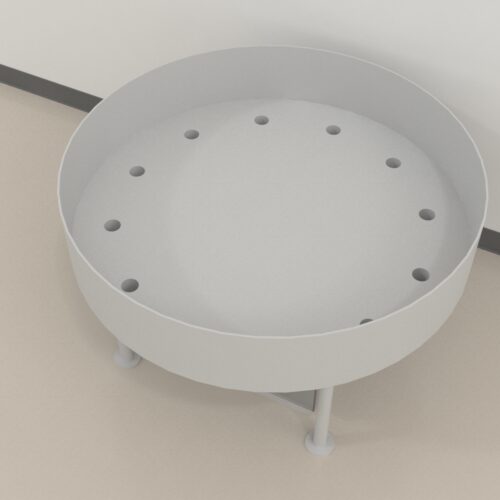 Circular Hole Board
Circular Hole Board
Circular Hole Board
A hole board apparatus with removable inserts and easy cleaning. Affordable for your budget. Great exploration data for the best price.
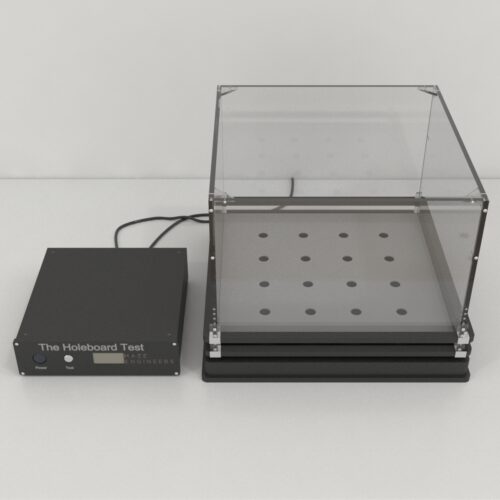 Activity Hole Board
Activity Hole Board
Activity Hole Board
Automated hole board system is used for the detection of nose poke behaviour in the open field environment with maximum flexibility.
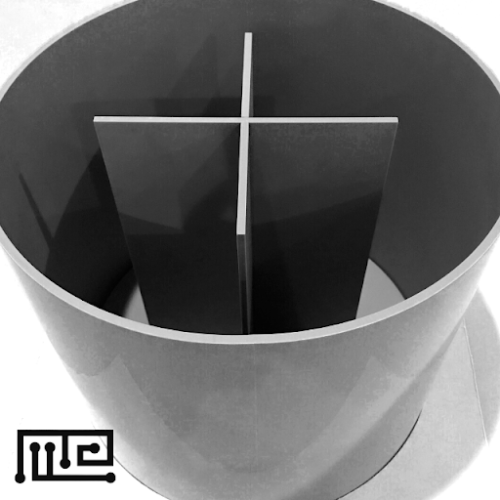 Circular Open Field
Circular Open Field
Circular Open Field
Open Field test is a popular protocol used to assess exploratory behavior and anxiety.
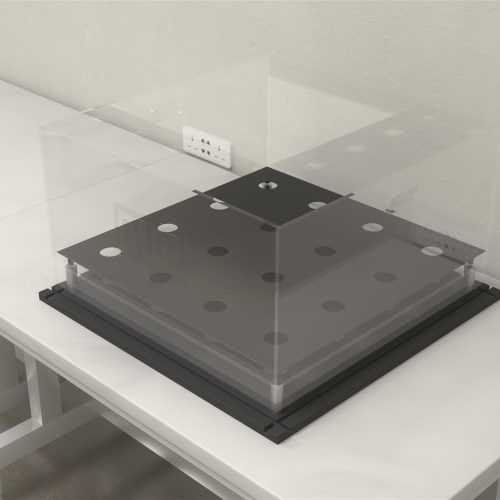 Hole Board
Hole Board
Hole Board
A hole board apparatus with removable inserts and easy cleaning. Affordable for your budget. Great exploration data for the best price.
 Novel Object Recognition
Novel Object Recognition
Novel Object Recognition
Open Field test is a popular protocol used to assess exploratory behavior and anxiety.
 Open Field
Open Field
Open Field
Open Field test is a popular protocol used to assess exploratory behavior and anxiety.
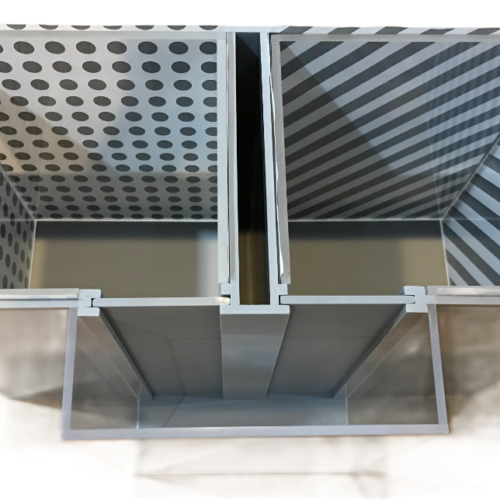 Conditioned Place Preference
Conditioned Place Preference
Conditioned Place Preference
The conditioned place preference chamber is a paradigm widely used to explore the reinforcing effects of natural and pharmacological stimuli

